How to Make Window Like Unity Animator
Update note: Eric Van de Kerckhove updated this tutorial for Blender 3.0 and Unity 2022.3 LTS.
Artists create 3D characters for your favorite games with the apply of models, textures and animations.
In the by, characters needed to have the verbal same skeleton to share animations. This express grapheme multifariousness equally their meridian and proportions had to be the same too. As an amusing example, the older FIFA games had players all be the same size because creating a separate skeleton — and a set of animations — would have been a nightmare.
Nowadays, most game engines come with a organisation to let reusing animations as long every bit the skeletal hierarchy is compatible. This allows yous to use the same animations for characters of all shapes and sizes. In Unity, this organization is called Mecanim. It allows for easy gear up of animations, the blending between them and retargeting of humanoid animations between models.
Being able to reuse animations allows you to use animations from the asset store and websites like mixamo.com for your ain custom characters. This saves a ton of time!
In this tutorial, y'all'll learn how to fix a humanoid model using Blender and how to bring it into Unity. More specifically, y'all'll learn how to:
- Create an armature (skeleton) for a character and rig information technology
- Enhance the graphic symbol with accessories and objects
- Export a model to FBX
- Import Blender models into Unity
- Create and tweak a humanoid avatar
- Adhere objects to a character
- Animate a humanoid in Unity
Time to jump right in!
Getting Started
Earlier you brainstorm, verify you come across the following requirements:
- You lot've downloaded and installed the latest 2022.3 LTS release of Unity.
- The latest stable 64-flake version of Blender is installed on your car.
- You have a minimal understanding of the Unity editor. Cheque out some of the beginner tutorials on the website.
- Some feel with Blender is recommended. Hither is a good tutorial to get started.
Download the source materials by clicking the link at the top or bottom of this tutorial and unzip it somewhere.
Open the Starter binder and navigate to the Assets\RW\Models folder. Now open CuteCharacter.blend in Blender.
The file contains the following:
- A low poly humanoid grapheme model
- The CuteCharacter material
- A reference to the CuteBase texture contained in the aforementioned folder as the model
Afterward opening the file, you lot should run across the character model on the left:

Note that information technology'south mirrored on the X-axis, meaning its left and right side are identical. This will brand the whole procedure a lot easier along the way.
The right side of Blender has a simple texture image loaded:

Time to get to work! The start step to animating this character is rigging it.
Rigging the Graphic symbol
Rigging is the art of creating an armature, the skeleton of the model. An armature has bones to which y'all can connect vertices, so they move along whenever a os gets moved around.

Hover over the 3D View to bring it into focus. Now add a new armature past holding Shift and pressing A to open the Add Menu. Adjacent, select Armature to add the first bone.

You've now created the armature and its first bone, also known as the "root bone". With the armature nonetheless selected, find the In Front check box in the Viewport Display section of the Object Properties tab and check information technology.

The armature is now visible through the grapheme making the skeleton creation procedure a lot easier.

Before diving in and creating the total skeletal structure, information technology'due south of import to empathise how information technology needs to exist ready to exist compatible with Unity's Humanoid Avatar.
Due to the manner Unity maps the bones to its own system, some key bones are necessary.
![]()
Unity expects at least xv bones, which are:
- Hips (root bone)
- Lower spine
- Upper spine
- Neck
- Caput
- Two upper arms
- Two lower arms
- Two hands
- Two upper legs
- 2 lower legs
The rig y'all'll be creating includes all of the above bones and some extra ones for added stability when animating.
Make sure the armature is still selected and press Tab to enter Edit mode. Side by side, select the root os past clicking information technology.

At present open the Bone Properties tab on the right in the Backdrop editor and rename the root os to Hips past entering information technology in the proper noun field and pressing Enter.

Spine
With the starting time bone made, you tin at present transform it into a spine for the character.
Select the bottom, sphere shaped connector of the Hips os. Adjacent, press One thousand, Z, 0.five and Enter in sequence to move it up around where yous'd expect the center of the hips to be.

At present, select the superlative connector and press One thousand, Z, 0.ane and Enter to move it up a bit.

Note: If it'south difficult to see what yous're doing, y'all can zoom in and out using the scroll wheel.
To get more than spine bones, you'll demand to subdivide the Hips bone in 3 pieces. Select the Hips bone, right-click to open the context menu and select Subdivide. By default, this makes a unmarried cut, splitting the bone into two pieces. To increase the number of cuts, open the Subdivide carte at the lesser left of the 3D view and fix Number of Cuts to 2.

With the spine split, the new basic are named Hips.001 and Hips.002. That's not a proficient fashion of naming bones; rename the bones by selecting each one and changing the name in the Os Properties tab of the Properties editor on the right like yous did with the Hips bone.
Name the top one Chest and the middle one LowerSpine.

Legs
Next upwards are the leg bones. Duplicate the Hips bone by selecting information technology and and then pressing Shift + D. Next, motion it a tad to the right and right-click at the end to reset the position of the new os.

If yous look at the Bone Properties tab on the correct, you'll see a bone named Hips.001 selected.
Notation: Is the bone named Hips.003? In that case you might have forgotten to rename the other bones! No worries, yous can rename the bones now and so use the Outliner panel at the summit right to discover and select your newly created bone over again.
Rename this bone to UpperLeg.L. The L stands for left, this makes it clear what side the bone is on and volition help with mirroring later on.
This bone needs to indicate downward and be placed right above the articulatio genus. To start off, rotate the UpperLeg.Fifty bone 180 degrees on the Y axis by pressing R, Y, 180 and Enter in succession.

Now movement it in place horizontally past pressing Yard, Ten, .23 and Enter in that order. Subsequently that, press G, Z, -.2 and Enter to become it in position vertically.

Select the bottom connector and motility it down by pressing G, Z, -.iii and Enter in that gild.

You now have one large bone for a leg. If this character had wooden peg legs, this would've been perfect already! Most people have knees so they tin can bend their legs though, and so you'll need to make it bendable.
To do that, select the UpperLeg.L os, right-click and select Subdivide to carve up the leg in ii (ouch!). This results in two leg bones with a connector in the eye that will human action a knee. Get ahead and the new lesser os LowerLeg.L.

The last function of the legs are the feet. Switch to a side view past pressing three on your numpad and press period (.) on your numpad to focus on the lower leg.
Notation: Don't take a numpad? Y'all can click X-axis on the viewpoint gizmo at the meridian right of the 3D view to rotate the view to the right. To go a better view of the leg, zoom in using your curl cycle.


Now select the lesser connector and extend information technology to brand a foot bone by pressing E, Y, -.xviii and Enter.

Next, rename the newly created bone to Pes.L using the Bone Properties tab.
Now might be a skilful time to save the file. Press CTRL + S and you lot'll notice a small notice appearing at the bottom of the window. Feel gratuitous to practise this periodically, better safe than sad!

Switch back to the front view by pressing 1 on your numpad. Before moving on to the caput, you'll demand to parent the leg to the hips. Luckily this is pretty simple!
Select UpperLeg.Fifty and expand the Relations section of the Bone Properties tab. Click on the Parent drop-down and select Hips.

Torso
On to the head! Select the connector at the top of the Chest os, press Eastward, Z, .055 and Enter consecutively. This is the neck bone so proper noun it Neck in the Os Backdrop tab.

To add the head bone, go on the height connector selected and press E, Z, .95 and Enter in that guild.

Name the newly created bone Head.
Next is the left shoulder connector. Select the top connector of the Chest bone and printing E, X, .08 and Enter to add the new bone. Move it down a fleck past selecting the rightmost connector and pressing Chiliad, Z, -.09 and Enter.

Proper name this bone ShoulderConnector.50. This bone volition connect the breast to the shoulder. None of this is anatomically correct in any fashion, and it doesn't need to exist. :]
Next up is the arm itself! Select the rightmost connector of ShoulderConnector.50 and press E, X, .85 and Enter in that club. This creates one large bone that needs to exist split to create the remaining bones for the left side.

Select the newly made arm bone, right-click and choose Subdivide in the context carte. Modify the number of cuts in the bottom left to 3, so yous go four pieces in total.

Name these basic as follows, from left to right:
- Shoulder.L
- UpperArm.L
- LowerArm.L
- Paw.L

The way these bones are laid out might look good at first glance, just because the way the connector between the arm pieces sits (also known as an elbow), the arm won't be able to bend correctly. Concur Z to open the shading menu and drag your cursor to the left to enter the wireframe view.

Now have a look at the bend in the arm:

The red line indicates where the elbow is now and the white line indicates the arm'southward bending betoken on the mesh. To fix this, select LowerArm.L and movement it to the correct by typing G, X, .09 and Enter.

Now switch back to Solid rendering by holding Z and moving your cursor to the right.
That's it as far every bit calculation bones goes. How about the right side though? Well, I don't know most y'all, but I'll take any shortcut I tin become to get the work done! That's why the side by side pace is mirroring the basic on the left to the correct with a few keystrokes.
Mirroring
Blender has a groovy feature to quickly mirror the bones of an armature in but a few simple steps! To starting time off, deselect all bones past holding Alt/Option and pressing A. Adjacent, select the basic on the grapheme'south left side (the right side when seen from the front) by holding Shift and clicking the bones 1-by-one. Don't forget about the foot!

With those bones selected, right-click and select Symmetrize in the context menu. This is all you need to practice to get a perfect mirrored version of the selected basic:

The bones volition as well all have .R automatically at the end of their name instead of .L to signify what side of the body they're used for.
At present save the file and prepare to move on to rigging.
Weight Painting
Weight painting is the procedure of binding basic to a 3D mesh. Each os gets attached to a group of vertices with a certain amount of weight.
The weight decides how "hard" the vertices will be pulled and pushed by the bone.

Doing this manually would take a while since y'all'd have to paint the weight of every single bone. Luckily, Blender tin take care of well-nigh of the grunt work by automatically weight painting based on how close the basic are to the vertices. This works by parenting the model to its armature and letting Blender automatically assign weights.
Press Tab to switch to Object mode. Click on the character model to select it, so hold Shift and click the armature to select that besides. The social club you do this in is important, as the last selected object volition be the parent. Now press CTRL + P to open up the Parent card and cull With Automatic Weights to parent the model to the armature and perform automatic weight painting.
On to the absurd part! Select the armature, then change to Pose mode with the driblet-down at the tiptop left. Now select a bone and rotate it around past pressing R and moving your cursor around. Do this with each bone on the center and the model'due south left side to cheque if everything the basic were weighted correctly.

Later checking all of the basic, you may have noticed the eyes don't move with the head, which looks a bit weird, to say the least!
To adhere the eyes to the head, you'll need to practice some actual weight painting. Keep the armature in Pose manner, and then agree Shift and click the model to add it to the pick. Now enter Weight Pigment way and gear up to practice some painting.

This mode shows both the bones and the weight fastened to them on parts of the model.
Start off by deselecting all basic past pressing ALT/Option + A. Next, hold Shift and click on the Head bone to select it. The weight colors go from dark bluish, to green and finally ruby. As you can run across, the eyes are dark blue, which means they aren't attached to the caput os at all! To attach those optics to the caput os yous'll need to increase their weight.
For easier access to the optics and to strengthen the outcome of adding weight, rotate the head os backward past pressing R, Ten, -90 and Enter in that club. Information technology looks grizzly, but don't worry, he won't experience a thing!

To attach the eyes to the Caput os, information technology needs some weight added to it. To start off, select the Add brush in the Brush department of the tool console at the top left. By default, this is set to Decrease.

Now paint on the eyes to increase the weight until the optics aren't floating anymore.

To check out the issue, reset the view past pressing numpad 1 and printing Alt (or Option) + R to reset the rotation of the Caput os. The eyes are at present correctly connected to the head.

Note: The rotation to a higher place was done using trackball rotation. You can activate this rotation way by pressing R two times.
With the basic weight painting done, it'due south time to add some details.
Adding Accessories
Accessories in this context are objects that are attached to the character merely aren't a part of its body. This section discusses two ways of attaching objects: to the model itself and equally a split up, reusable object that connects to a bone.
The former is a simple hat, and the latter is a weapon for the character to hold.

Before continuing, press A two times followed by Alt (or Option) + R to reset the rotation of all bones.
Editing the Character
The first way of calculation more details to your graphic symbol is easier to work with, but it comes with some limitations. As you lot'll be working on the model itself — which is mirrored — all geometry added volition be copied from the left side to the right and vice-versa. This makes it impossible to add anything unique to one side. Because the geometry is a role of a particular model, information technology also can't be reused for other characters. It's perfect for whatever situation where those limitations aren't a trouble.
If you lot've followed forth with the tutorial until now, you lot'll probably still be in Weight Paint mode. Press Tab to enter Edit style and kickoff off by switching the selection mode to Vertex by pressing i on your number row or by clicking the first button right of the mode dropdown.

At present select any vertex above the red line (which is an UV seam used for texturing) on top of the head by clicking on information technology. Next, printing CTRL + L to select all connected vertices, this selects the whole model. Now select the UV delimiter by selecting UVs in the bottom left panel. The top of the caput will be selected now.

Select the edge loop underneath as well by belongings Shift and Alt (or Choice) and then clicking on whatever of the first horizontal edges beneath.

Now indistinguishable the selected faces past pressing Shift + D and then clicking. Move the duplicated faces upward a flake past pressing G, Z and 0.01 followed past Enter to confirm.

Adjacent, calibration the whole selection upward by pressing S, i.05 and Enter. This moves the hat abroad from the head a fleck, then yous don't cease upward with some of the faces Z-fighting.
The hat is still floating around, so do the following to attach it to the model:
- Select just the lesser row of the "hat" by pressing ALT/Option + A to deselect everything. At present select the bottom edge row of the chapeau by belongings Alt (or Option) and clicking on one of the bottom edges.
- Make information technology directly by press S, Z and 0 in that social club.
- Press Due east to extrude and press Enter to confirm.
- Press S to start scaling and motion your cursor towards the model until the edges are inside of the head. Rotate the view around to brand this easier to see. Click to ostend the scaling.

This gave the hat some depth so it can look all right from all sides without any holes. A hat made from human pare probably isn't what you had in listen though! To modify the colour, you'll have to unwrap its UVs commencement so it can fit nicely on the texture.
Select the entire hat by selecting any vertex on the hat and then pressing CTRL + Fifty. Change the delimiter to Normal this time to select all the connected vertices. For this hat, you'll perform one of the easiest unwraps in being: from the current view. Press numpad one to go a front view, then printing U to open the Unwrap menu and select Project From View.

If you wait at the correct side of the Blender window where the texture is visible, you lot'll notice some vertices were added that look like to half of the hat:

You can select all of these by moving your cursor over to the texture and pressing A. Actions in Blender are context sensitive depending on where your cursor is placed, so brand sure to go along it somewhere within the region of the texture for now.
Now press K to motility the UVs over to the blue splotch, confirm the movement by clicking so scale the choice downward until information technology fits inside the blue region past pressing Southward and confirming by clicking over again.

If you at present wait at the grapheme again, you'll notice his hat turned blue!

Now, position the cursor back somewhere nearly the model on the left and press Tab to return to Weight Pigment mode. Rotate the Head bone around a scrap to check if the hat is continued.

It looks similar you're in luck! Because the vertices of the hat are all and so virtually to the Head bone, they're included automatically. If this wouldn't be the case, you'd have to paint the chapeau like you did with the eyes.
Next upwardly is creating and attaching a separate object.
Attaching Objects
For this function, yous'll be creating a elementary staff that will deed equally a weapon for the character to hold. It's easy to imagine a sword, an axe or fifty-fifty a magic wand instead, but creating a complex weapon is outside the scope of this tutorial.
Get into Object mode and press Shift + A to open the Add bill of fare. Select Mesh > Cylinder to add together a new cylinder to the scene.

The default cylinder is also large, so adjust the cylinder parameters in the bottom left: alter Radius to 0.04 and prepare the Depth to 1.2.

This makes the cylinder thinner and shorter. Now make the cylinder smooth by right-clicking to open the context card and selecting Shade Shine.
The cylinder doesn't accept any textile assigned yet, and so it looks grey and bland. To assign a fabric, open the Textile tab in the Backdrop editor on the correct and select CuteMaterial from the drop-downward next to the New push.

To plow the cylinder into a dark-brown staff, you'll need to unwrap its UVs outset. Press Tab to enter Edit fashion, press U to open the Unwrap carte du jour and select Project From View.
Move your cursor over the texture on the right, press G to start moving the UVs and move it over the brown patch on the texture. Confirm the motion with Enter and calibration information technology down by pressing S and moving your mouse, so the UVs fit inside.

The staff is now brown colored. Don't worry about the awkward positioning; yous'll exist dealing with that next.

Open the Object Constraint Properties tab in the properties editor. Add a new constraint by clicking the Add Object Constraint drop-downward and selecting Kid Of.

Constraints limit the position, rotation and/or calibration of an object. In this case, it'll exist used to parent the cylinder to the manus bone of the character. This way — if you create any animations — the object will exist attached to the paw at all times. This makes previewing the animation a lot easier and allows you to preclude the object from intersecting with the body.
Setting upward the Child Of constraint is straightforward. Click the Target drib-downwardly and select Armature. At present click the Bone drop-downwardly and select Mitt.R. You can type the name of the bone in this fields to make selecting it easier.

After doing this, you'll observe the staff snaps to the graphic symbol's right hand. The position isn't quite right though, and so move it forward a chip by pressing G, Y, -0.4 and Enter. Much better!

Time to put the staff to the test. Select the armature and switch to Pose fashion. Now rotate the view so yous can see the staff clearly, select UpperArm.R and rotate it around a bit by pressing R and moving your mouse around. The staff volition continue post-obit the paw around every bit if the character held information technology.

The character and its accessories are now done. Salve the file and pat yourself on the back for a job well done!
Next upwards is exporting the model and the armature to Unity.
Exporting to Other Formats
Annotation: If you're non interested in exporting models to other formats then y'all can share them with other people, feel complimentary to skip this section. Just salve the file and shut Blender.
Unity tin handle Blender's .blend just fine as long as Blender is installed on the system. Even so, when sharing models with dissimilar people, it'due south often better to apply a format like .FBX or .OBJ that doesn't require any other software. That's also the reason why most of our tutorials come up with .FBX model files instead of .blend files.
Exporting to FBX with Blender is easy. To start, select File > Export > FBX (.fbx) in the top menu.

You'll now see a Blender File View window. Yous can cull a location to save the file by choosing a folder on the left or by typing in the location direct at the top. The export settings are at the right side of the window:

These default export settings will work with Unity, just there's a chance they might make a mess in more complex scenes as it will consign everything, even lamps and cameras. To make a clean export, make the following changes:
In the Include section, deselect Camera, Lamp and Other. You tin can do this by holding down Shift and clicking the options you lot want to disable.

With these options selected, yous won't get any undesired objects exported. At present bank check the Apply Transform checkbox at the lesser of the Transform department. This applies the position, rotation and scale of all objects. That means whatever non-uniform values volition be reset; if the rotation was set to (X:23, Y:125, Z:7), for example, it will be set to (X:0, Y:0, Z:0).

Side by side, open up the Armatures department, bank check Only Deform Bones and uncheck Add Leaf Basic. This prevents Blender from adding extra bones to the armature. Leaf bones are only needed for compatibility with Maya. Non-deform bones like command bones are just needed in the modeling software to make precise adjustments; they're useless in a game engine like Unity.

The default Blitheness options are fine, so you lot don't need to tinker with those.
Now that you take all of this set up, it would be tedious if you needed to do this every single time you want to consign a file. That's where the presets come up in. You lot tin can save all of these settings in Blender'southward internal options for later use.
To practice this, click the + push next to the Operator Presets drop-downwards at the peak, type a name for the preset in the textbox and click the OK push. For the sake of this tutorial feel gratuitous to name information technology Unity FBX.

If you now open the Operator Presets drib-down, you lot can select the newly fabricated preset:

Doing so will instantly utilise the settings. This works beyond all files, so from at present on you can export any Blender file to FBX for utilize in Unity. The final step is the actual exporting. This tutorial uses the .blend file in Unity for animating, and so experience gratis to salve the FBX file anywhere you want past selecting a folder on the left and pressing the Export FBX button at the top correct.

Save the file and close Blender. It's finally fourth dimension to leap into Unity and use the model!
Setting Up a Humanoid
Open the starter project in Unity and look at the Avails folder in the Projection view.
Here'south a quick overview of what these are for:
- Animations: Contains a unproblematic idle animation.
- Materials: The materials of the character and the dojo.
- Models: Hither'due south where you lot edited and saved the character. It also includes the dojo model and some textures.
- Music: An Asian inspired song to become into the dojo mood.
- Scenes: The Dojo scene.
If it's not already open up, open the Dojo scene from the Scenes folder.

With the overview out of the way, on to using the graphic symbol!
Avatar Mapping
To start, select the CuteCharacter model in the Models folder and open the Rig tab in the Inspector. Open up the Animation Blazon drop-down and select Humanoid.

This flags this character as a humanoid one, so Unity can use information technology as such. Now click Apply to salvage these settings.
After a short re-import, you'll notice the Configure… push button is now enabled. Click this button to kickoff linking the bones to Unity'southward Mecanim system.

Look at the Scene view and rotate the view around until the grapheme faces you. Notice the greenish bones; these are the ones Unity uses internally. Clicking any of these will select the respective bone in both the Hierarchy and in the Inspector.

The way Unity uses these bones is by interim like a puppeteer. Instead of straight up using animation files to update the bones every frame, information technology reads the values and applies those to every humanoid based on their Avatar definition. This allows for flexibility when information technology comes to body shapes. Take the character you've been working on, for case; its proportions are not realistic, just that doesn't thing as its skeleton is also adjusted to fit while yet having the essential bones like a spine, arms, legs, etc. Some of the bones may be shorter than in most humans, only they're at that place.
Now focus on the Inspector, you lot'll see a human shape with green and gray circles spread effectually. All solid circles are necessary for the Avatar system to work. If any of these are missing, they'll plow red, and yous won't be able to breathing the grapheme correctly.
The dotted ones are optional bones for more circuitous rigs. Any body parts that are grayed out are missing, but not essential. This character doesn't have whatever fingers for example.

Below that is the full overview of the basic, and this is where you need to link body parts to bones. If whatever of the circles are red, you lot'll need to (re)assign a os. The skeleton you've fabricated is entirely up to spec when it comes to Unity, so no adjustments are necessary. Hurray!

Switch to the Muscles & Settings tab at the pinnacle of the Inspector. This allows y'all to view and tweak the virtual muscles.

You lot'll at present see 3 sections:
- Muscle Group Preview
- Per-Muscle Settings
- Additional Settings
The first 1 has several sliders y'all tin can movement from left to right to test if the muscles are mapped correctly. Try them out and see what they practise. Note that the finger ones won't accept any consequence since the graphic symbol doesn't accept any fingers. Press the Reset All button after every test to reset all preview sliders.

The Per-Musculus Settings section contains sub-sections that can be unfolded by clicking the arrow next to them. Every 1 of these has some more specific previews and allows you to specify the minimum and maximum angles to forbid overlapping for your specific model.

Expand the Left Arm section and endeavor sliding around the Arm Downwards-Up slider. Notice what happens with the minimum value selected:

The arm is moving through the graphic symbol's body. Ouch! To set this, set the preview slider to its lowest value and modify the minimum angle of Arm Down-Up to -20.

Do the same for Correct Arm > Arm Down-Upwards.

That concludes the tweaking of the muscles. At that place are more muscles you can tweak to prevent overlapping, but for the sake of this tutorial you tin can leave them at their default settings.
Press the Use button at the bottom-right to salvage the changes to the Avatar and press Done to close the mapping way.

At present it'south time to add the character to the scene and requite information technology an blitheness to play.
Using the Character
To add the character, drag the CuteCharacter model from the Models folder into the Hierarchy.
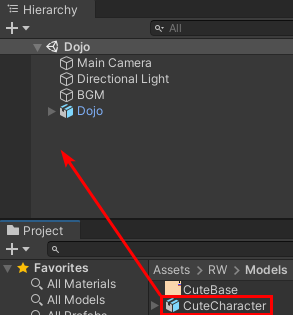
At present set the rotation of CuteCharacter to (10:0, Y:180, Z:0), so it's facing towards the photographic camera. Side by side, create a new animation controller by right-clicking the RW\Animations folder and selecting Create > Animation Controller.
Name it CharacterController and double-click information technology to open the Animator window. Now drag the Idle blitheness from the RW\Animations folder onto the Animator grid to brand information technology the default blitheness.

Next, select CuteCharacter in the Hierarchy and click the selector button side by side to the Controller field. Select CharacterController in the selection window.
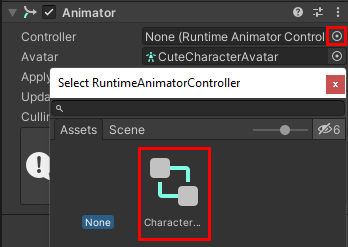
As a final pace, you'll need to attach the weapon the character's right hand. To do this, outset off past make the grapheme into a prefab past creating a new Prefabs folder in the Assets/RW folder and dragging CuteCharacter to it.
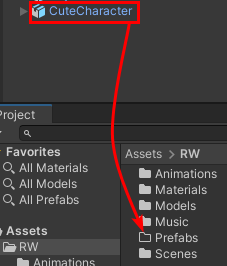
A popup volition appear asking y'all what type of prefab y'all desire to create, select Original Prefab here.
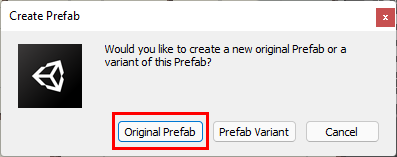
Now double click the CuteCharacter prefab you only created to open it in Prefab Mode. Aggrandize CuteCharacter in the Hierarchy and drag Cylinder to Hand_R to parent it. This is the limitation of adding a split up object as I discussed earlier. Non doing this will outcome in the weapon just floating effectually the grapheme.
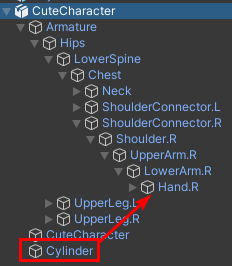
At present exit Prefab Style by clicking the arrow button below the + button at the tiptop left of the Hierarchy.
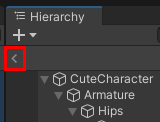
That's it! Press the play button to see the character in motion.
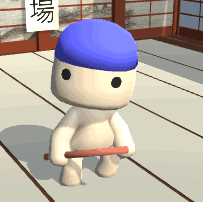
Now printing the play push button over again to stop the scene and press CTRL + S to salve the changes you've fabricated.
Where to Go From Here?
Congratulations on finishing this tutorial. You can download the final project using the link at the top or bottom of this tutorial.
In this tutorial, you learned how to:
- Create an armature (skeleton) for a character and rig it
- Modify the grapheme with accessories and objects
- Export to FBX
- Import Blender models
- Create and tweak a humanoid avatar
- Attach objects to a character
- Animate a humanoid in Unity
To apply the knowledge you've gained, y'all can create some accessories yourself and give them a dissimilar colour or pattern. If you know some modeling, yous tin can also create a character from scratch and rig it.
To larn more about Blender, cheque out these tutorials:
To learn more about Mecanim and the Avatar organization, read this weblog postal service by Unity.
Thank you so much for reading this tutorial to the end. If you have any questions or comments, feel free to join the discussion below.
How to Make Window Like Unity Animator
Source: https://www.raywenderlich.com/31539225-creating-reusable-characters-with-blender-and-unity


Comments
Post a Comment